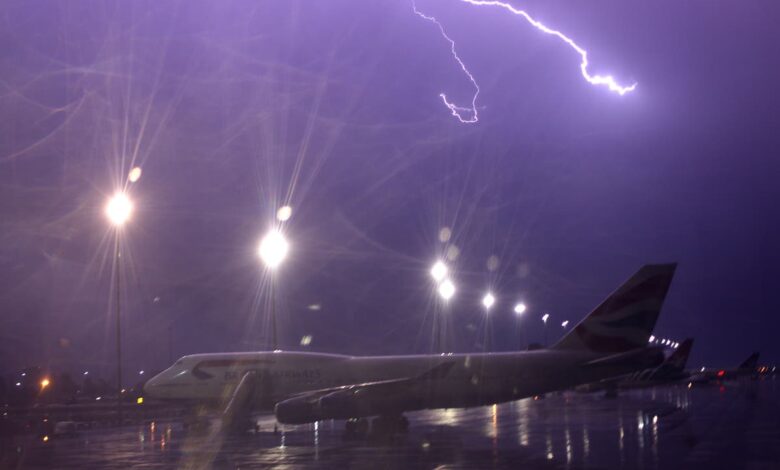How the climate crisis is making flying more dangerous

“It all happened in a span of 5 to 7 minutes,” says Hemal Rajesh Doshi, one of the 195 passengers aboard the Boeing 737-800 flight operated by Indian airline SpiceJet that encountered severe turbulence flying to Kolkata from Mumbai on 1 May this year.
The incident left 14 passengers and three of the flight’s cabin crew injured.
“About an hour and a half into the flight, without any announcement, it was like the plane suddenly fell and passengers were in panic. I saw about four to five passengers literally thrown into the air and some hit the flight’s roof and fell. The moment was like being on a roller coaster,” Mr Doshi tells The Independent, recounting what he calls a ”horrible, life-threatening” experience aboard the plane.
While the results of an official investigation into the incident are pending, experts suspect the plane may have encountered a severe localised thunderstorm called a Nor’wester while trying to steer clear of erratic air currents shortly before landing.
“The pilot deviated to his left in order to avoid turbulence but did not get alerted about the upcoming issue in his deviated path,” SpiceJet said in a statement at the time.
A growing number of studies indicate that erratic air circulation patterns like these are aggravated by the climate crisis, and the results can have serious implications for passenger safety. In March 2019, a Boeing 777 flight operated by Turkish Airlines from Istanbul to New York encountered an incident of severe clear-air turbulence (CAT) over Maine, hospitalising 30 people, including a flight attendant who suffered a broken leg.
CAT is caused by an erratic wind current occurring in the cloudless regions of the sky at about the cruising altitude of passenger jets. It is generated by wind shear – a change in the direction and velocity of winds that can displace aircraft abruptly from their intended path.
Experts say thunderstorms and atmospheric phenomena like CAT and jet streams are already being influenced by global heating, leading to the likelihood of more disruptions in airline operations.
Thousands of planes already experience severe turbulence every year, costing the aviation sector up to $1bn annually through flight delays, structural damage to aircraft and injuries to passengers and cabin crew.
“Climate change is going to have many effects on aviation. We expect the atmosphere to become more turbulent. So there could be possibly twice or three times as much turbulence on flights in the next few decades,” Paul Williams, professor of atmospheric science at the University of Reading in the UK, tells The Independent.
Emerging evidence suggests non-uniform temperature changes caused by the climate crisis are disrupting the flow of air currents in the atmosphere due to changes in wind speed and direction.
One such current airplanes routinely use to assist transcontinental flights is the Atlantic jet stream – a fast, narrow current of air flowing from west to east that encircles the globe.
Airplanes, especially those travelling east from North America, use this jet stream to cut down on their travel times and fuel use in the same way turtles in the movie Finding Nemo use the East Australian ocean current for migration, explains Krishna AchutaRao, head of the Centre for Atmospheric Sciences at the Indian Institute of Technology (IIT), Delhi.
“We know that the jet stream at flight cruising altitudes has become 15 per cent more sheared over the North Atlantic since satellites began observing it in the 1970s,” Dr Williams says.
A 2017 study published in the journal Advances in Atmospheric Sciences, looked at the impact of stronger wind shear – an abrupt change in wind speed or direction over a short distance that is a major cause of turbulence – on winter-time transatlantic flights.
It found that the doubling of global CO2 levels will increase the average amount of severe CAT at 39,000ft by 149 per cent, meaning airline passengers will have a bumpier ride in the future if emissions continue unabated.
Improved turbulence forecasting capabilities will be needed so route changes to avoid turbulence do not lead to increased fuel burn, says Eurocontrol, an international organisation working to achieve safe and seamless air traffic management across Europe.
“Avoiding unexpected turbulence can lead to route extensions and increased fuel burn/CO2 emissions; so improving the capability to forecast turbulence means routes can be better planned and reduce additional track miles,” a spokesperson for Eurocontrol tells The Independent.
It is not only through air current disturbances that the climate crisis could impact passenger safety, scientists warn, but also with extreme weather events like storms and tropical cyclones – which are proven to be more common and more powerful due to global warming.





